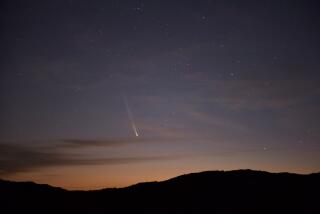Warming Up With a Little Ice
- Share via
By now everyone knows that Halley’s comet will make one of its periodic visits to the vicinity of the Earth early next year. Telescopes, books, T-shirts, ashtrays and other paraphernalia to mark the occasion are already flooding the market, but the U.S. government couldn’t come up with the money to launch a probe to the comet, which swings by these parts once every 76 years or so.
On Wednesday, though, an American spacecraft will pass through the tail of another comet, Giacobini-Zinner, and give the world its first close-up look at comets and what they are made of. There has been much speculation about those heavenly wanderers, but no one knows for sure.
This is a space mission done on the cheap, which in itself is remarkable for space missions. Four years ago Robert W. Farquhar of the space agency’s Goddard Space Flight Center in Greenbelt, Md., cleverly suggested taking a satellite already in space and rerouting it for a rendezvous with Halley’s. That proved impractical, but the next best thing was to send the satellite to Giacobini-Zinner. So the comet probe is being conducted without building or launching a new spacecraft. The cost of the added mission was only $3 million. Satellites alone can cost $100 million or more.
The current theory is that comets are sort of “dirty snowballs”--relatively small chunks of ice that create tails when they approach the sun. The renamed International Cometary Explorer Satellite that is almost at Giacobini-Zinner is expected to help answer what is going on up there. It should also be a lesson for the National Aeronautics and Space Administration that sometimes much can be accomplished with a little money.






